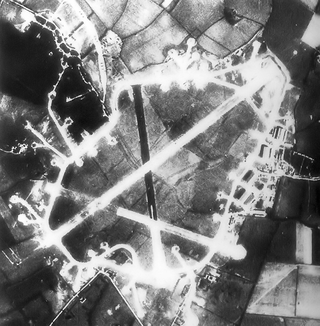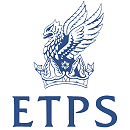
No. 206 Squadron is a Test and Evaluation Squadron of the Royal Air Force. Until 2005 it was employed in the maritime patrol role with the Nimrod MR.2 at RAF Kinloss, Moray. It was announced in December 2004 that 206 Squadron would disband on 1 April 2005, with half of its crews being redistributed to Nos. 120 and 201 Squadrons, also stationed at Kinloss. This was a part of the UK Defence Review called Delivering Security in a Changing World; the Nimrod MR.2 fleet was reduced in number from 21 to 16 as a consequence.

Royal Air Force Waddington otherwise known as RAF Waddington is a Royal Air Force station located beside the village of Waddington, 4.2 miles (6.8 km) south of Lincoln, Lincolnshire, in England.

Royal Air Force Leeming or more simply RAF Leeming is a Royal Air Force station located near Leeming, North Yorkshire, England. It was opened in 1940 and was jointly used by the RAF and the Royal Canadian Air Force (RCAF). Between 1950 and 1991, it operated mostly as a training base with Quick Reaction Force (QRF) Panavia Tornado F3 fighters based there in the latter stages of the Cold War and into the early 21st century. Since 2006, it has become the home of the deployable RAF communications cadre and the home of No. 135 Expeditionary Air Wing.

Remote Radar Head Benbecula or RRH Benbecula, is an air defence radar station operated by the Royal Air Force. It is located at Cleitreabhal a'Deas, 17 kilometres (11 mi) from Lochmaddy on the isle of North Uist in the Outer Hebrides of Scotland.

Royal Air Force Leconfield or more simply RAF Leconfield is a former Royal Air Force station located in Leconfield, East Riding of Yorkshire, England.

Royal Air Force Wyton or more simply RAF Wyton is a Royal Air Force station near St Ives, Cambridgeshire, England. The airfield is decommissioned and is now home to the Joint Forces Intelligence Group.
Royal Air Force Bircham Newton or more simply RAF Bircham Newton is a former Royal Air Force station located 2.1 miles (3.4 km) south east of Docking, Norfolk and 13.4 miles (21.6 km) north east of King's Lynn, Norfolk, England.

MDP Wethersfield is a Ministry of Defence facility in Essex, England, located north of the village of Wethersfield, about 6 mi (9.7 km) north-west of the town of Braintree. Originally an RAF station, the original accommodation areas have now been converted to become the headquarters and training centre of the Ministry of Defence Police.

Royal Air Force Thurleigh or more simply RAF Thurleigh is a former Royal Air Force station located 5 miles (8.0 km) north of Bedford, Bedfordshire, England. Thurleigh was transferred to the United States Army Air Forces Eighth Air Force on 9 December 1942 and designated Station 111, and used for heavy bomber operations against Nazi Germany.
Aberporth Airport is situated southwest of Aberporth, Ceredigion, Wales. The airport is being developed as West Wales Airport for domestic flights. It is also developing as a centre for the deployment of civil and military unmanned aerial vehicles (UAVs), known as 'drones'. The airport underwent major improvements in 2008 which extended the length of the runway from 945 to 1,257 m.

Remote Radar Head Portreath or RRH Portreath is an air defence radar station operated by the Royal Air Force. It has a coastal location at Nancekuke Common, approximately 1.25 kilometres (0.78 mi) north east of the village of Portreath in Cornwall, England.

The Empire Test Pilots' School (ETPS) is a British training school for test pilots and flight test engineers of fixed-wing and rotary-wing aircraft at MoD Boscombe Down in Wiltshire, England. It was established in 1943, the first of its type. The school moved to RAF Cranfield in October 1945, then to the Royal Aircraft Establishment, Farnborough in July 1947, before returning to Boscombe Down on 29 January 1968.
The Aeroplane and Armament Experimental Establishment (A&AEE) was a research facility for British military aviation from 1918 to 1992. Established at Martlesham Heath, Suffolk, the unit moved in 1939 to Boscombe Down, Wiltshire, where its work continues following privatisation as part of the Qinetiq company.

RAF Hullavington was a Royal Air Force station located at Hullavington, near Chippenham, Wiltshire, England. The station opened in June 1937 and was primarily used for training. It closed on 31 March 1992 when it was transferred to the British Army and renamed Buckley Barracks. The airfield part of the site, known as Hullavington Airfield, continued to be used for RAF gliding operations until 2016 when it was sold to technology company Dyson.

RAF West Freugh is a former Royal Air Force station located in Wigtownshire, 5 miles (8 km) south east of Stranraer, Dumfries and Galloway, Scotland.
The Rotary Wing Test and Evaluation Squadron (RWTES) is a tri-service UK military organisation based at MoD Boscombe Down, Wiltshire. Primarily, the squadron is responsible for test and evaluation of rotary wing aircraft and equipment, or their associated modifications.

The Air and Space Warfare Centre (ASWC) is a Royal Air Force research and testing organisation based at RAF Waddington in Lincolnshire. It has a training branch nearby as a lodger unit of RAF Cranwell and other branches elsewhere, including at RAF High Wycombe, RAF Brize Norton, MoD Boscombe Down, and RAF Odiham.

Royal Air Force Manorbier, or more simply RAF Manorbier, was a Royal Air Force airfield near Manorbier, Pembrokeshire, Wales. The site was first used in 1933 as a mixed civilian/military airfield and was the base for 'Y' Flight of No. 1 Anti-Aircraft Co-operation Unit RAF in 1937, using de Havilland DH.82 Queen Bee unmanned radio-controlled target drone. The airfield was passed on to the War Office in September 1946.

Royal Air Force Church Fenton or RAF Church Fenton is a former Royal Air Force (RAF) station located 4.3 miles (6.9 km) south-east of Tadcaster, North Yorkshire, England and 6.3 miles (10.1 km) north-west of Selby, North Yorkshire, near the village of Church Fenton.




















